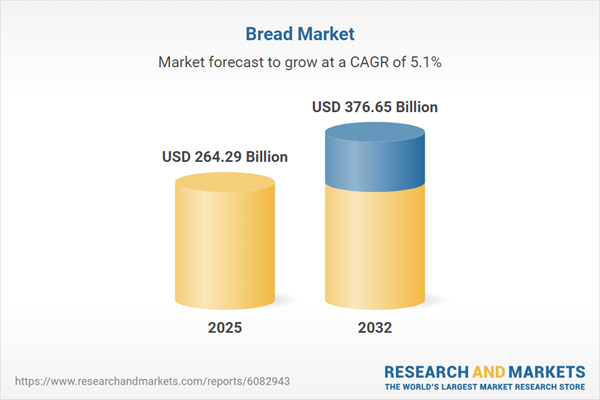Speak directly to the analyst to clarify any post sales queries you may have.
The bread market is transforming as consumer priorities, supply chain challenges, and product innovation redefine strategies for manufacturers and stakeholders globally.
Market Snapshot: Bread Market Growth and Trends
The bread market expanded from USD 252.04 billion in 2024 to USD 264.29 billion in 2025, posting a compound annual growth rate (CAGR) of 5.14%. The sector is projected to attain a value of USD 376.65 billion by 2032. This consistent growth underscores the impact of evolving consumer needs, technological enhancements, and regional expansion within the baking industry.
Bread Market Scope & Segmentation
The report delivers comprehensive insight into the breadth and depth of the bread market across products, production methods, formats, channels, and regions. Key segmentation categories include:
- Product Types: Artisan & Specialty (including baguette, ciabatta, focaccia), Flatbreads (lavash, naan, pita, tortillas), Gluten-Free Bread, Loaf Breads (multigrain, rye, sourdough, white, whole wheat), and Low-Carb/Keto.
- Baking Methods: Artisanal baked, microwave, par-baked, traditional oven.
- Bread Shapes: Sliced, unsliced.
- Shelf Life: Extended shelf life, fresh (short-life), frozen.
- End Users: Commercial (bakeries, cafés, restaurants), Household, Institutional (hospitals, schools).
- Distribution Channels: Offline retail (convenience stores, specialty stores, supermarkets & hypermarkets), Online retail (brand websites, ecommerce platforms).
- Regional Coverage: Americas (North America, Latin America), Europe, Middle East & Africa, Asia-Pacific. Specific countries and subregions include the United States, Canada, Brazil, United Kingdom, Germany, France, United Arab Emirates, South Africa, China, India, Japan, Australia, and others.
- Profiles of Leading Companies: Major players analyzed include Almarai Company, Associated British Foods plc, Grupo Bimbo, Yamazaki Baking Co., Ltd., Flowers Foods, Inc., Aryzta AG, Panera, LLC, and additional global and regional producers.
Key Takeaways for Senior Decision-Makers
- Consumer shifts toward healthful, artisanal, and convenient bread varieties are reshaping R&D priorities and accelerating the adoption of specialty and functional products across multiple global markets.
- Digitalization and advanced manufacturing solutions—such as precision fermentation and AI-driven quality monitoring—are strengthening value chain efficiency and product consistency, raising competitive benchmarks across the sector.
- Sustainability imperatives drive ingredient sourcing, packaging innovation, and climate-smart partnerships, aligning business operations with evolving regulatory and stakeholder expectations.
- Regional market variations highlight the necessity for localized strategies, including product adaptation and distribution models tailored to specific consumer behaviors, retail ecosystems, and regulatory environments.
- Strategic partnerships across ingredient suppliers, technology providers, and distributors are enabling companies to scale operations, mitigate volatility, and access new growth channels.
- Ongoing policy changes, such as tariffs on baking inputs, reinforce the value of supply chain agility and contingency planning for sustained market relevance.
Tariff Impact: Navigating Policy Shifts
Recent tariffs in the United States have raised input costs for specialty and alternative grains, influencing procurement and distribution decisions across the industry. Manufacturers are responding by increasing reliance on domestic suppliers and reconfiguring logistics and supply agreements. These adaptation strategies highlight the critical need for flexible sourcing and robust risk management to preserve competitiveness in a policy-affected landscape.
Research Methodology & Data Sources
The analysis leverages a multi-method approach, combining primary executive interviews, structured industry surveys, proprietary sourcing intelligence, and secondary research. Advanced analytics—including regression, scenario modeling, and network mapping—support in-depth trend validation. Findings are vetted through an expert advisory panel for methodological soundness and relevance.
Why This Bread Market Report Matters
- Enables business leaders to identify untapped product and channel opportunities through clear segmentation analyses and regional mapping.
- Equips strategy teams with evidence-based insights on market transformation drivers, ensuring alignment of innovation, operations, and supply chain investments with evolving consumer and policy dynamics.
- Supports operational optimization by detailing actionable recommendations tailored to market realities, competitive frameworks, and sustainability expectations.
Conclusion
The bread market is evolving due to shifting consumer demands, regulatory changes, and technological progress. Stakeholders who leverage these actionable insights will be positioned to navigate complexity, foster innovation, and capture emerging value across the baking industry value chain.
Table of Contents
3. Executive Summary
4. Market Overview
7. Cumulative Impact of Artificial Intelligence 2025
Companies Mentioned
The companies profiled in this Bread market report include:- Almarai Company
- Associated British Foods plc
- Angel Bakeries
- Aryzta AG
- Bakers Delight Holdings Limited
- Barilla Group
- Biscuit International SAS
- Brace's Bakery Limited
- Britannia Industries Limited
- Campbell Soup Company
- EUROPASTRY S.A.
- Finsbury Food Group Plc
- Flowers Foods, Inc.
- Fuji Baking Group
- George Weston Limited
- Gold Coast Bakeries Pty. Ltd.
- Goodman Fielder Pty Limited by Wilmar International Limited
- Grupo Bimbo
- H&S Bakery, Inc.
- Harry-Brot GmbH
- Hostess Brands, LLC by The J.M. Smucker Co.
- Lantmännen Unibake A/S
- MAPLE LEAF FOODS INC.
- Modern Bakery LLC
- Panera, LLC
- Premier Foods Group Limited
- Slow Dough Bread Co.
- Vandemoortele NV
- Warburtons Limited
- Yamazaki Baking Co., Ltd.
Table Information
| Report Attribute | Details |
|---|---|
| No. of Pages | 185 |
| Published | November 2025 |
| Forecast Period | 2025 - 2032 |
| Estimated Market Value ( USD | $ 264.29 Billion |
| Forecasted Market Value ( USD | $ 376.65 Billion |
| Compound Annual Growth Rate | 5.1% |
| Regions Covered | Global |
| No. of Companies Mentioned | 31 |









